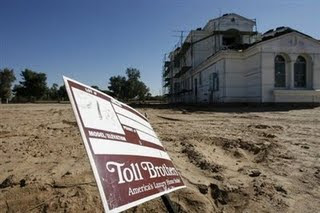Home Builder Sentiment Sinks in April
 The NAHB Housing Market Index Fell but it Should Not be Construed as the Overriding Barometer for Real Estate
The NAHB Housing Market Index Fell but it Should Not be Construed as the Overriding Barometer for Real Estate
The National Association of Home Builders (NAHB) today released its latest tally of home builder sentiment, and the news reported was not good, especially for the heart of the important spring selling season. However, it does not necessarily reflect poorly for real estate generally, nor does it condemn housing stocks even.
Our founder earned clients a 23% average annual return over five years as a stock analyst on Wall Street. "The Greek" has written for institutional newsletters, Businessweek, Real Money, Seeking Alpha and others, while also appearing across TV and radio. While writing for Wall Street Greek, Mr. Kaminis presciently warned of the financial crisis.
Relative tickers: NYSE: BAC, OTC: FMCC.OB, OTC: FNMA.OB, NYSE: GS, NYSE: MS, NYSE: WFC, NYSE: TD, NYSE: SRS, NYSE: URE, NYSE: IGR, NYSE: XIN, Nasdaq: RYHRX, Nasdaq: TRREX, NYSE: TOL, NYSE: HOV, NYSE: DHI, NYSE: BZH, NYSE: LEN, NYSE: KBH, NYSE: PHM, NYSE: NVR, NYSE: GFA, NYSE: MDC, NYSE: RYL, NYSE: MTH, NYSE: BHS, NYSE: SPF, NYSE: MHO, AMEX: OHB, NYSE: VNQ, NYSE: PNC, NYSE: JPM, Nasdaq: HOFT, NYSE: ETH, NYSE: PIR, NYSE: WSM, NYSE: HD, NYSE: LOW, AMEX: VAZ, AMEX: NKR, AMEX: MZA, AMEX: NXE, AMEX: NFZ, Nasdaq: XNFZX, Nasdaq: FSAZX, Nasdaq: AVTR, NYSE: AIV, NYSE: EQR, NYSE: AVB, NYSE: UDR, NYSE: ESS, NYSE: CPT, NYSE: SNH, NYSE: BRE, NYSE: HME, NYSE: MAA, NYSE: ELS, NYSE: ACC, NYSE: CLP, Nasdaq: AGNC, NYSE: SUI, NYSE: AEC, NYSE: PMT and AMEX: TWO, NYSE: DIA, NYSE: SPY, Nasdaq: QQQQ, NYSE: DOG, NYSE: SDS, NYSE: QLD, NYSE: NYX, NYSE: ICE, Nasdaq: NDAQ
Home Builder Sentiment Sinks in April
 The home builders' association reported the NAHB/Wells Fargo Housing Market Index fell one point, to 16 in April. That reflects poorly for the voiced views of most home builders. However, using this index as a broad measure of the state of the real estate market would be a mistake. First of all, there is regional variation currently evidenced within this report, which should be expected at inflection point. Imagine taking a snow globe and rushing it downward to a sudden stop. You would find the "snow" inside unsettled, with some rising and some falling, rather than all rushing downward at once. The "globe" is in a situation of flux, from which broad direction is unclear. That's the state of the real estate market now. This report also does reflect the optimism that exists in some regions of the market.
The home builders' association reported the NAHB/Wells Fargo Housing Market Index fell one point, to 16 in April. That reflects poorly for the voiced views of most home builders. However, using this index as a broad measure of the state of the real estate market would be a mistake. First of all, there is regional variation currently evidenced within this report, which should be expected at inflection point. Imagine taking a snow globe and rushing it downward to a sudden stop. You would find the "snow" inside unsettled, with some rising and some falling, rather than all rushing downward at once. The "globe" is in a situation of flux, from which broad direction is unclear. That's the state of the real estate market now. This report also does reflect the optimism that exists in some regions of the market.
The Southern Region of the nation basically drove the overall decline in sentiment, with the South falling four points to a regional index mark of 15. However, the congested Northeast saw improvement, gaining two points, to a mark of 20. The Midwest also rose, gaining two points to a slim mark of 14. The important Western region stuck at 17 in April. That said, the South represents the largest and most important new home market in the US currently, so weakness in the South still means a lot to the overall home building industry. Also, the absolute numbers reported here are all clearly weak. While that's important to home builders, change in direction and pace matter more to securities markets than absolute numbers in the determination of investment.
We remind readers that the NAHB includes the views of many small builders who face disadvantage now, given their more constrained capital situation. While large publicly traded builders are typically well capitalized, the smaller players, who are still aplenty, cannot get loans as easily today as they could five years ago. This index includes the small builder's views and is biased by them.
The NAHB lists the usual complaints from a builders' group that stands to benefit from government aid if its collective voice is loud enough. Some of these complaints are certainly true, and all of them carry weight though. These complaints include the effect of foreclosures on the appraisals of homebuyers making a trade up. Those homes for sale are burdened by the effect of foreclosure sales on a comparative pricing model. But the NAHB Chief Economist says "more foreclosures seem to be hitting the market," and that's just inaccurate. Just last week, RealtyTrac reported a 15% decline in first quarter foreclosure activity. It would be hard to fathom April being worse than the preceding months.
The NAHB reported that the index measuring current sales activity slipped one point, to 16. Even so, the measure of foot traffic of prospective buyers gained a point, to 13. However, the metric for the forward six month outlook fell sharply, shedding three points to a reading of 23. We expect this is directly related to rising uncertainty and creeping prices generally.
We believe that the most significant threat to this year's broadly anticipated housing recovery would be that caused by uncertainty with regard to the geopolitical situation and its impact on energy prices, namely gasoline. Gasoline is at a point now that it is affecting every consumption decision, especially those involving big ticket items like homes. Thus, while this data is not supportive of housing recovery on the surface, I'm not sure it should be expected to be an early indicator either.

Editor's Note: Article should interest investors in Bank of America (NYSE: BAC), Freddie Mac (OTC: FMCC.OB), Fannie Mae (OTC: FNMA.OB), Goldman Sachs (NYSE: GS), Morgan Stanley (NYSE: MS), Wells Fargo (NYSE: WFC), Toronto Dominion (NYSE: TD), UltraShort Real Estate ProShares (NYSE: SRS), Ultra Real Estate ProShares (NYSE: URE), ING Clarion Global Real Estate Income Fund (NYSE: IGR), Xinyuan Real Estate Co. (NYSE: XIN), Rydex Real Estate Fund H (Nasdaq: RYHRX), T. Rowe Price Real Estate Fund (Nasdaq: TRREX), Toll Brothers (NYSE: TOL), Hovnanian (NYSE: HOV), D.R. Horton (NYSE: DHI), Beazer Homes (NYSE: BZH), Lennar (NYSE: LEN), K.B. Homes (NYSE: KBH), Pulte Homes (NYSE: PHM), NVR Inc. (NYSE: NVR), Gafisa SA (NYSE: GFA), MDC Holdings (NYSE: MDC), Ryland Group (NYSE: RYL), Meritage Homes (NYSE: MTH), Brookfield Homes (NYSE: BHS), Standard Pacific (NYSE: SPF), M/I Homes (NYSE: MHO), Orleans Homebuilders (AMEX: OHB), Vanguard REIT Index ETF (NYSE: VNQ), PNC Bank (NYSE: PNC), J.P. Morgan Chase (NYSE: JPM), Hooker Furniture (Nasdaq: HOFT), Ethan Allen (NYSE: ETH), Pier 1 Imports (NYSE: PIR), Williams Sonoma (NYSE: WSM), Home Depot (NYSE: HD), Lowes (NYSE: LOW), AMEX: VAZ, AMEX: NKR, AMEX: MZA, AMEX: NXE, AMEX: NFZ, Nasdaq: XNFZX, Nasdaq: FSAZX, Avatar Holdings (Nasdaq: AVTR), Apartment Investment & Management (NYSE: AIV), Equity Residential (NYSE: EQR), Avalonbay Communities (NYSE: AVB), UDR Inc. (NYSE: UDR), Essex Property Trust (NYSE: ESS), Camden Property Trust (NYSE: CPT), Senior Housing Properties (NYSE: SNH), BRE Properties (NYSE: BRE), Home Properties (NYSE: HME), Mid-America Apartment (NYSE: MAA), Equity Lifestyle Properties (NYSE: ELS), American Campus Communities (NYSE: ACC), Colonial Properties (NYSE: CLP), American Capital Agency (Nasdaq: AGNC), Sun Communities (NYSE: SUI), Associated Estates (NYSE: AEC), PennyMac Mortgage (NYSE: PMT), Two Harbors (AMEX: TWO).
Please see our disclosures at the Wall Street Greek website and author bio pages found there. This article and website in no way offers or represents financial or investment advice. Information is provided for entertainment purposes only.

Labels: Economic Reports, Homebuilders, Housing, Real Estate











1 Comments:
Good point about the smaller home builders skewing things. I agree.
Post a Comment
<< Home